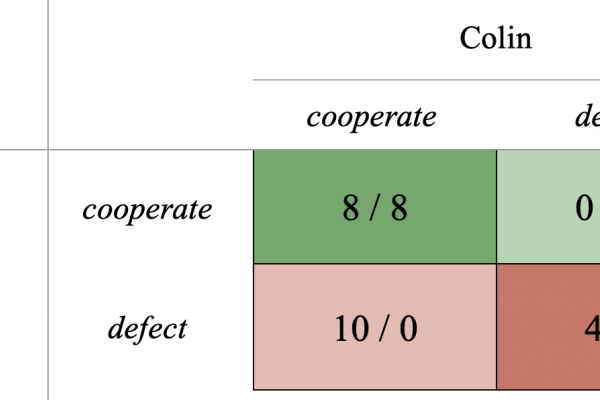
Prisoner's Dilemma

The prisoner's dilemma is a game used by researchers to model and investigate how people decide to cooperate—or not.
Imagine that Prisoner A and Prisoner B are charged with a crime and detained separately, and each has the chance to give a confession. Neither prisoner knows what the other will choose to do. There are several possible outcomes:
- If only one prisoner confesses, the confessor is set free, but the non-confessor serves a three-year sentence.
- If neither prisoner confesses, both serve a one-year sentence.
- If both confess, both serve two years.
Should Prisoner A keep quiet, or betray Prisoner B by admitting to the crime? This is the classic version of the prisoner's dilemma.
Many other versions of the dilemma have been created, including ones in which each participant stands to gain more or less depending on their decisions, as well as other set-ups in which multiple games are played sequentially. The structure of the prisoner's dilemma was described by mathematicians in the 1950s and has since been used as a model for real-world situations and applied in domains such as psychology, economics, and political theory.
The prisoner's dilemma also encapsulates the conflict that can arise between individual and collective interests: In many scenarios (think arms races or the use of limited natural resources), incentives encourage individual people or countries to make self-serving choices, even though the broader community would benefit from cooperation.
Mathematician Albert Tucker is credited with formalizing and popularizing the prisoner’s dilemma. Many others have studied and expanded it, including political scientist Robert Axelrod, who developed a version in which participants in the exercise engage in multiple interactions.
The prisoner’s dilemma represents an isolated incident, but relationships in the real world are not typically limited to single interactions. Subsequent versions of the prisoner’s dilemma have depicted repeated encounters, in which parties make decisions based on the choice at hand as well as how the other party previously acted. Considerations of retaliation, reward, and trust become increasingly relevant in these scenarios.
In versions of the prisoner’s dilemma in which the two parties have repeated encounters, a strategy called tit for tat is often most successful. This strategy involves Party A cooperating with Party B on the first round, and then adjusting behavior to match Party B’s subsequent behavior. If Party B cooperates, Party A continues to cooperate; if Party B defects, Party A responds by retaliating against them.

The prisoner's dilemma, like other games used by researchers, can illuminate how people make decisions about cooperation and betrayal under different conditions.
In the classic version of the dilemma, the "rational" choice, given all the possible outcomes, is to betray the other player. But adding additional rounds of the game—and thus the potential for retaliation by one who is betrayed—can change the equation.
Psychologists continue to use the prisoner's dilemma (and similar games) to explore dynamics such as how memory affects adaptive decision-making and whether intuitive thinking boosts cooperation.
Thinking about the prisoner’s dilemma and the characters’ competing interests can be a helpful analogy when considering the relationship between the present self and the future self. In the case of addiction, for example, having a cigarette or a drink is in the interest of the present self but not the future self; people who choose abstinence may do so because it maintains the credibility of their sobriety and builds trust between the present and the future self.
Yes. For example, the debate about gun ownership in the United States is in part informed by the prisoner’s dilemma. Individuals have a choice to carry a gun or not. Research shows that societies are safer when no one owns guns. However, individuals may worry that someone else feels differently and is therefore carrying a weapon. If so, that would put them at a disadvantage, prompting them to carry a gun, too.
Game theory can help clarify the dilemma of cooperation, revealing why “getting along” isn’t as simple or as natural as many would wish. At the same time, it shows that human beings aren’t necessarily doomed to a world of endless defection if they can be persuaded to take a wider view of their situation and their opportunities. These lessons of the prisoner’s dilemma can be applied to international conflicts such as conflicts in the Middle East and the Vietnam War.














